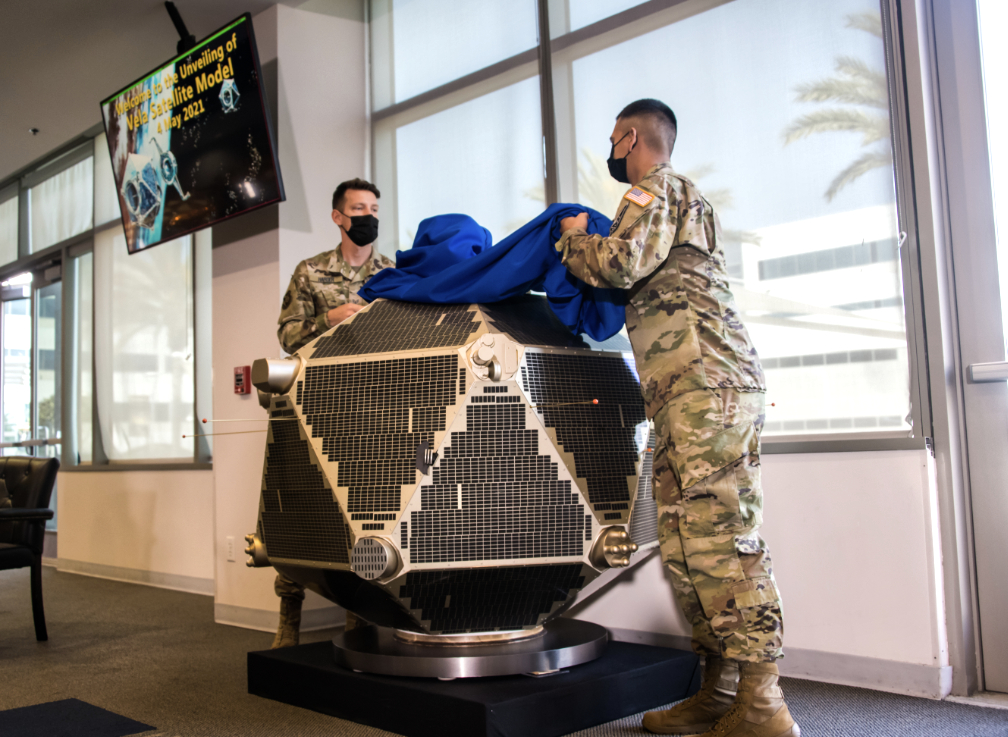
Representatives from Northrop Grumman presented a full-scale Vela satellite model to the U.S. Space Force’s Space and Missile Systems Center at the Los Angeles Air Force Base in California on May 4, 2021.

During the unveiling event, Lt. Gen. John F. Thompson, Commander of SMC and Air Force Program Executive Officer for Space, thanked Northrop Grumman for the donation and said the model will be on permanent display at SMC, to inspire future generations of Airmen and Guardians.

“We’re happy to have this model continue to stand here as a testament to those programs and those people who came before us and the incredible systems those organizations of the past created that modeled the way for all of us to create similarly innovative and remarkable satellite systems in the future, with our industry partners,” Thompson said.
The Vela satellite system was the first space-based system used for nuclear surveillance. Originated on December 15, 1960, by the U.S. Air Force Ballistic Missile Division, the Atomic Energy Commission and NASA, this system was designed to detect nuclear detonations by detecting neutrons, x-rays and gamma ray radiation from nuclear explosions in the Earth’s atmosphere.
“The ability to detect nuclear detonations has played a key role in preventing nuclear war, throughout the entire nuclear age, from the earliest days of the cold war until now,” Thompson said. “Before the Vela satellites, the U.S. and our NATO allies used a range of sensors to ‘sniff’ for nuclear particles in the air around the world,” such as the WC-135 “sniffer” jets.”
“The successful collaboration of government and industry teams is noteworthy on numerous technical and scientific fronts, including the speed at which the satellites were developed and launched,” said Tom Wilson, vice president and general manager of the Strategic Space Systems Division of Northrop Grumman. “This speed enabled the inaugural pair of Vela Hotel satellites to be launched on Oct. 17, 1963, within one week of the Partial Nuclear Test Ban Treaty going into effect. This was followed by a 21-year-run of high reliability and precision nuclear detection without a gap in coverage.”
Built by TRW, which later became part of Northrop Grumman, there were a total of 12 satellites, launched in pairs. Each satellite was 54 inches in diameter, 46 inches high and had a liftoff weight of 730 pounds and an orbital weight of 511 pounds. Its orbit was 60,000 nautical miles above the Earth and its original design life was 18 months, although the satellites were operational for many years beyond that.
The Vela program also provided scientific data on natural sources of space radiation including for the Apollo space program. In 1967, the satellites were the first to detect extra-terrestrial gamma-ray bursts, thought to be the brightest and most energetic electromagnetic events in the universe. The last Vela satellite was safely shut down in 1984, but the mission of monitoring nuclear detonations continues with payloads hosted on GPS satellites.
Other ceremony attendees from SMC included: Col. Tim Sejba, Program Executive Officer for Space Development; Col. John Dukes, Deputy Program Executive Officer for Space and Director of Staff; Chief Master Sergeant Lisa Arnold, Command Chief Master Sergeant; and Cordell DeLaPena Jr., program executive officer for space production; along with Jim Simons from the Air Force Association; and Steve Scott, Maj. Gen. (Ret.), Tav Taverney and Bob Marohn from the SMC Heritage Society.
Other Northrop Grumman officials who attended the ceremony included Cyrus Dhalla, vice president of Communications Systems for the Space Systems division; Ron Squires, leader of Digital Transformation for Strategic Space Systems Division; and Arnie Streland, Corporate Executive Lead, Los Angeles Northrop Grumman, Strategy & Development.
